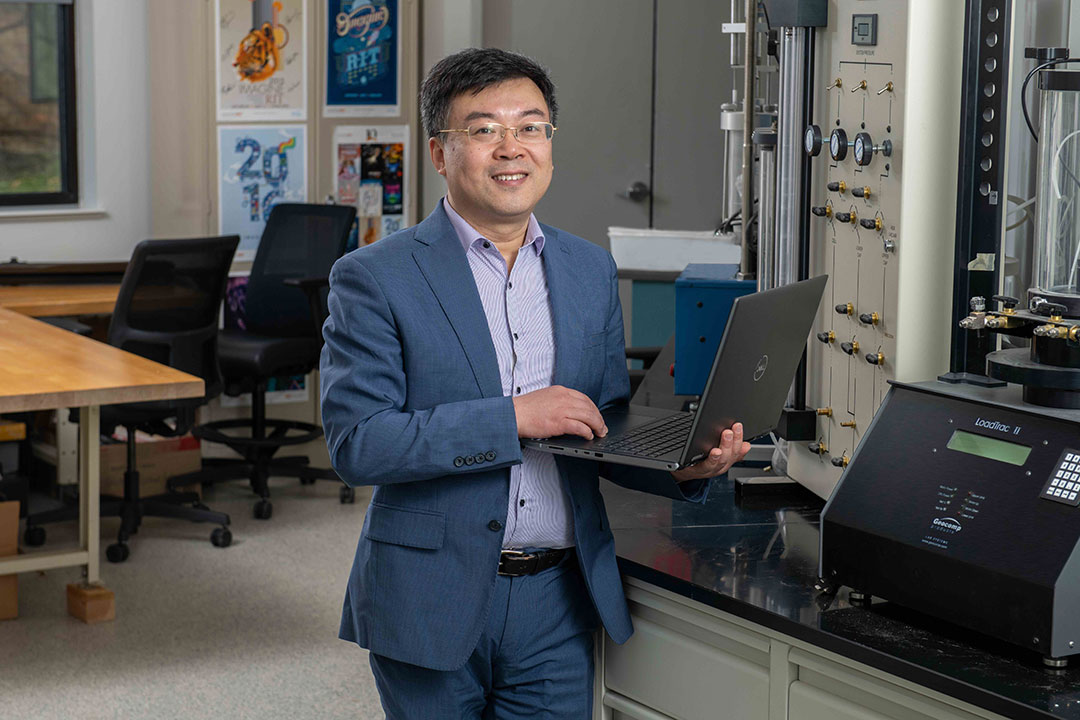Researcher receives funding to improve infrastructure safety for nuclear waste disposal
Outcomes will inform Nuclear Regulatory Commission on advanced safety strategies in the event of seismic events and temperature changes
Carlos Ortiz
Professor Lu Sun works in his transportation studies research lab to better understand the effects of temperature and seismic events on concrete structures used for nuclear disposal.
Researchers at Rochester Institute of Technology are investigating the combined physical effects of heat, chemical reactions, and seismic activity on concrete lining structures used to dispose of nuclear waste. Results from the work could improve nuclear waste infrastructure designs, better long-term safety management, and refine strategies to meet climate change targets.
Lu Sun, a professor in RIT’s College of Engineering Technology (CET), received a grant of nearly $500,000 from the Nuclear Regulatory Commission for “High temperature and seismic response of concrete lining structures and clay in nuclear waste disposal.” The three-year collaborative project is part of an effort to improve disposal of nuclear waste in underground facilities, specifically targeting radiation-generated heating, vaporization, chemical reactions and seismic loading, or tremors, from earthquakes.
“Thermal, hydro, mechanical, and chemical processes are the key sciences involved in this project,” said Sun, chair of CET’s Department of Civil Engineering Technology, Environmental Management and Safety. “Typically, when we look at concrete material, we look at the structure, focusing on mechanical behavior. This means you are applying a load to the structure and you focus on the strength or stress on the material. But in reality things are more complicated.”
Concrete is a porous material that often holds moisture. Both radiation and underground environments generate high temperatures, causing different reactions in the concrete. This can potentially weaken protective structures or trigger destructive chemical, fracturing processes in concrete, Sun explained.
“That’s where we have the thermal properties that come into play. And also because of the radiation. Both can cause a chemical reaction because there are changes in the material at the molecular level. That is why we look at thermal, hydro, mechanical, and chemical processes together in this research so that we can precisely characterize the properties of concrete material for nuclear waste disposal. That’s what makes this scenario unique.”
Nuclear waste can come from substances emitted by powerful reactors; they can also be the radioactive materials used for medical procedures such as cancer therapies. Waste is moved to secured storage areas, most underground—common nuclear industry practices in the U.S., Japan, and Europe. Trends in the field today are toward integrating more green energies in addition to traditional oil, gas, and coal.
“Green energy involves nuclear energy, solar power, wind and geothermal resources, biofuel, batteries, and hydro-energy,” said Sun. “Communities need to collaborate and interact with complex infrastructure—energy, transportation, environment, cities—in smart, resilient, and sustainable ways to bring about better places to live, and in response to climate change.”
Sun is working on the research project with Toan Duc Cao, a CET adjunct faculty member with expertise in the area of porous materials and fracturing dynamics, and Sarah Finkeldei, assistant professor of chemistry at the University of California Irvine. Finkeldei’s research group explores materials chemistry in the nuclear fuel cycle. Sun and his research team, consisting of undergraduate and graduate students, are working in the transportation studies laboratory located in RIT’s Brown Hall.











